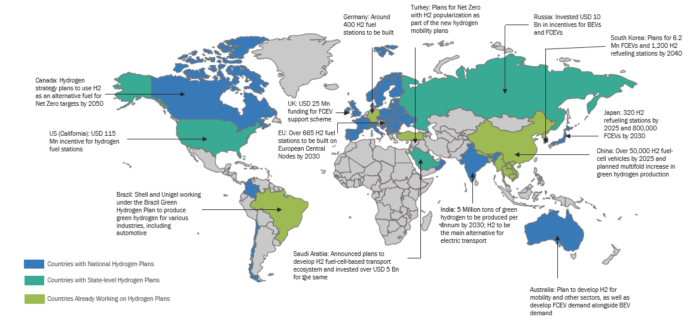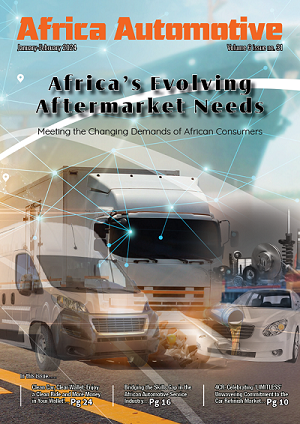In the rapidly evolving transportation landscape, a revolutionary shift is taking place toward green mobility. As the world plans to deal with the challenges of climate change and seeks sustainable alternatives to traditional modes of transportation, hydrogen emerges as a powerful contender. The higher driving range of FCEVs and growing consumer interest make hydrogen a potential alternative for zero-emission mobility. Further, growing investor participation, technological developments by OEMs, and the government’s plans for zero-emission transport are expected to make the market more lucrative. This transition to hydrogen mobility is already gaining momentum globally, particularly in heavy-duty transportation where FCEVs are becoming increasingly popular.
The hydrogen mobility market in 2023 was full of ups and downs across major markets. Most FCEV sales are concentrated in four key markets—China, South Korea, Europe, and the United States. The FCEV market in the Asia Pacific region fell by 24.9% in 2023. China held a 49% market share of FCEV vehicle sales in the region driven by higher sales of H2 buses and trucks. Further, the FCEV market in Japan and South Korea fell by more than 50% in 2023. This is primarily attributed to the inadequate hydrogen charging infrastructure and the increasing cost of H2 fuel resulting from disruptions in the hydrogen supply chain, with vehicle options restricted to the Hyundai Nexo or the Toyota Mirai. Additionally, the performance of BEVs have substantially improved over the period, making the competition tough for FCEVs.
In Europe, FCEV demand is mainly led by Germany, France, the Netherlands, and Switzerland. Despite a sharp decline of over 70% in the German market due to the end of FCEV subsidies, the passenger car segment remained the leader in Europe, capturing 80% of the market share. Simultaneously, there was a 4% growth in the market share of hydrogen buses in the European market as compared to 2022.
North America experienced moderate growth in its FCEV market in 2023, with the US maintaining a major share of 94% in the region. The hydrogen supply in California has experienced significant disruptions since August 2023. As a result, a majority of hydrogen stations in Southern California have either gone offline or are operating with reduced hours. Additionally, hydrogen fuel prices rapidly increased in 2023. These collective challenges cast uncertainty on the future viability of hydrogen fuel-cell vehicles in the US.
Due to the rising emission levels, increasing fuel prices, and the limited availability of fossil fuels, there has been a rising demand for zero-emission alternative fuel vehicles. This has been a significant factor in the increasing demand for hydrogen mobility during the last few years. Alternative technologies such as non-precious metal catalyst-based PEM FC, hydrogen fuel-cell packaged system modules, and compact and lightweight microstructures will increase the range, reduce the cost, and increase the vehicle’s overall efficiency. Powertrain technology developments are also expected to create new opportunities for the hydrogen-fuel vehicle market. Further, new hydrogen-based applications such as FCHEVs and H2-ICEVs will create new opportunities in the market.
Adoption of onsite H2 refueling and portable H2 refueling technology
The establishment of a comprehensive refueling infrastructure system that addresses all aspects of hydrogen fuel production, transportation, and utilization is necessary for the expansion and sustainability of the global hydrogen market. A robust hydrogen infrastructure will enhance operational efficiency, diminish end-user expenses, and consequently, stimulate increased adoption. Nevertheless, prevailing challenges arise from the limited accessibility of hydrogen refueling stations, posing obstacles to the scalability of hydrogen-based transportation. The shift to onsite hydrogen generation and the adoption of portable hydrogen refueling technology represent significant advancements in this challenging hydrogen infrastructure landscape, addressing both economic and environmental concerns. This transition is particularly crucial in North America, where the number of fixed hydrogen refueling stations has shown slowed growth.
Onsite hydrogen generation, which is carried out by electrolyzer processes, offers a sustainable solution by producing hydrogen at the station location. This approach eliminates the costs associated with hydrogen fuel transport and lowers energy losses due to simplified processes. This method also allows for the integration of renewable energy sources, such as wind or solar power, enabling the production of green hydrogen. Similarly, leading hydrogen providers such as Linde, Nikola, and Air Products have recognized the potential of portable hydrogen refueling options. Portable refueling technology is especially advantageous in regions where fixed infrastructure deployment may face challenges or delays.
Upcoming FCEV developments by leading OEMs
The FCEV market is expected to show significant growth and innovation, with major OEMs setting up to introduce over 12 new FCEV models by 2027. This move signifies a shift toward sustainable and zero-emission transportation solutions. Prominent OEMs such as Daimler, Volvo, and Scania, among others, have invested years in testing and development and now plan to enter the Class 7 & 8 Fuel Cell Electric Truck (FCET) segment. FCHEVs are also expected to have a growing presence across the fuel cell commercial vehicle segment. In addition, leading EV manufacturers such as BMW, KIA, and Hyundai are set to make their mark in the hydrogen fuel cell passenger car market in 2024. Further, companies such as Volkswagen are planning to enter the fuel cell van segment, challenging the current leader, Stellantis, in Europe. The Unique Selling Proposition (USP) of FCEVs, including zero tailpipe emissions, fast refueling capabilities, and long vehicle ranges, positions them as strong contenders in the sustainable mobility space.
OPPORTUNITIES IN HYDROGEN MOBILITY
The rise of hydrogen-powered trucks, led by prominent OEMs like Volvo and Daimler, shows the significance of hydrogen in shaping the automotive industry, particularly in the heavy commercial vehicles segment. These heavy-duty trucks, equipped with long-range hydrogen fuel cells, showcase a commitment to sustainable transportation solutions. Further, the plans for hydrogen ICE vehicles launch by OEMs such as Toyota, Porsche, Honda, Volvo, Tata Motors, MAN, Daimler, and Hyundai, present a promising alternative to FCEVs. Shifting to H2-ICE vehicle architecture will be easier than shifting to FCEV architecture for most traditional automakers due to the few changes required from traditional ICE architecture. Leading players are also actively exploring alternative fuel cell configurations to reduce reliance on precious metals, thus contributing to a potential reduction in fuel cell prices. Similarly, the evolution of new business models, such as pay-per-mile and hydrogen fuel card setups, promises lucrative opportunities in the near future. As automotive OEMs strategically backward integrate, developing their refueling infrastructure, hydrogen production units, and fuel cell component manufacturing, they will not only strengthen their market position but also contribute significantly to the overall growth and viability of hydrogen mobility.
• Innovative FCEV business models to create new opportunities for OEMs
The fleet-based business model for FCEV involves OEMs such as Hyundai leasing their FCEVs to fleet providers such as H2EG. In this model, H2EG acts as an intermediary, offering fleet services to customers. On the other hand, the Pay-per-mile business model, exemplified by OEMs like Riversimple, offers a direct-to-consumer approach. Customers can access FCEVs on a pay-per-mile basis, providing a cost-effective solution for those who may not need a vehicle constantly. Toyota’s Subscription-based business model takes a different route by partnering with third-party providers like Carify. This model allows customers to subscribe to FCEV services, providing them with the convenience of subscription-based vehicle access without the need for ownership. The H2 fuel card business model introduces a seamless and user-friendly approach to refueling FCEVs, with OEMs like Toyota partnering with H2 fuel providers such as Shell. Further, the Green H2 production business model, as demonstrated by Hyundai, involves the OEM taking an active role in the production of green hydrogen.
• Hydrogen use cases in heavy-duty commercial vehicles
Hydrogen has emerged as a promising and sustainable alternative in heavy-duty commercial vehicles, particularly in transit buses and class 8 trucks. Leading OEMs such as Hyundai, Toyota, Daimler, Nikola, Zhongtong Bus, and Yutong Bus, among others, have actively embraced hydrogen fuel cell technology by deploying their FCEBs (Fuel Cell Electric Buses) and FCETs (Fuel Cell Electric Trucks) in regions like Asia Pacific, Europe, and North America. China is a global leader in adopting hydrogen-powered buses and trucks worldwide. Further, Europe is witnessing a surge in demand for fuel-cell transit buses. The region has set ambitious goals, with plans to have over 1,200 fuel-cell electric transit buses operational by 2025 with an investment of USD 116 million. In the United States, the hydrogen landscape is evolving rapidly, driven by the country’s USD 7 billion Hydrogen Hub plan. This initiative aims to establish hydrogen stations or hubs across the nation.
• Hydrogen use cases in off-road vehicles
Hydrogen fuel cells have been increasingly adopted in various off-road industrial vehicles, showcasing a promising trend that began in the early 2010s. One prominent sector utilizing hydrogen fuel cell technology is the material handling industry, with companies like Hyster Yale, Toyota Material Handling, Hangacha, and Doosan Bobcat incorporating fuel cells in forklifts and tow tractors. In the construction industry, hydrogen fuel cells are gradually making their mark in vehicles such as excavators, loaders, dump trucks, concrete mixers, and cranes. Leading companies like JCB, Anglo, Terex, Adrighem, and Hyundai are currently testing fuel cell applications with limited commercialization. However, the sector is expected to witness significant growth from 2026. Mining vehicles have also embraced hydrogen fuel cell technology, primarily in mining trucks and dump trucks. Companies like Komatsu and Anglo are exploring ways to expand the use of fuel cells to other mining equipment in the coming years. Hydrogen fuel cells have also found their way into off-road utility vehicles, including all-terrain vehicles (ATVs), utility task vehicles (UTVs), snowmobiles, and golf carts. Key players such as Toyota, Yamaha, BRP, and Spectronic have recently launched these vehicles in 2022-2023. With lower power requirements for these utility vehicles, commercialization is anticipated to gain momentum from 2025.
• Development of H2-ICE as an alternative for Hydrogen in Transportation
H2-ICE vehicles present a practical alternative to FCEVs, offering advantages such as an established supply chain, quicker refueling times, and lower operational costs. Adopting H2-ICE vehicles by leading OEMs such as Toyota, MAN, and Daimler signifies a significant shift towards hydrogen-powered transportation. Since 2022, these OEMs have been actively developing and testing H2-ICE prototypes. Key automotive engine manufacturers, including Bosch, Cummins, Mitsubishi, and Garrett, are also gearing up for a commercial launch of their H2-ICE engines by 2025. Commercial vehicles are anticipated to be the primary segment for H2-ICE engines in the upcoming years.





